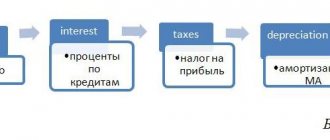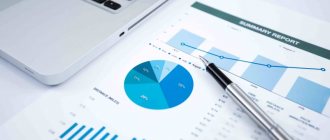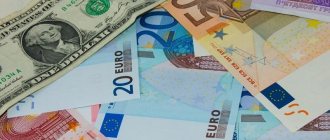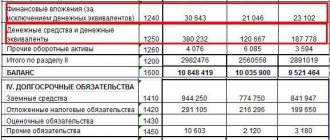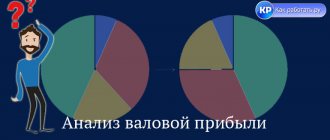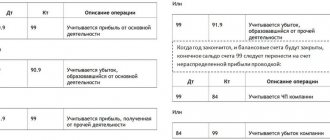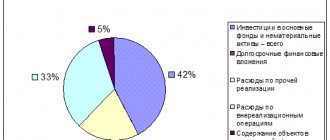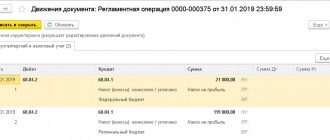Hello, Vasily Zhdanov is here, in this article we will look at the operating profit of an enterprise. In economic theory, operating profit (OP) is understood as the profit received by an enterprise from its core activities (OA). It is calculated as the difference between gross profit (GP) and expenses for core activities. Please note that:
- According to RAS, in terms of terminology, OP is actually equated to profit from sales. Therefore, it is often called the result (income, loss) from sales, which is also associated with the display of OP in financial statements.
- OP and earnings before taxes, interest (=EBIT) are largely similar, but essentially different from each other.
Important! EBIT, unlike OP, includes, among other things, non-operating income. That is, those incomes and expenses that do not relate to normal, core activities. If they are absent, then OP coincides with EBIT.
The OP indicator appears in the financial statements of the enterprise and is used in analyzing its profitability and in assessing the effectiveness of the enterprise’s OD. For example, with his participation, return on sales (ROS) is calculated to find out what percentage of OP the company receives from a specific sales volume. ROS is calculated using the generally used formula:
The OP indicator is crucial for investors and is important even for a small business entity. activities.
Composition, display, increase in operating profit
OP includes 3 components: cost and volume of products sold, as well as its range. An OP is formed on the account. 90, and at the end of the month is written off to the financial result (DT 90.9 KT99). It is displayed in the financial results report (OKUD 0710002, Order of the Ministry of Finance of the Russian Federation No. 66n dated July 2, 2010) on line 2200. This line is called, literally: “Profit (loss) from sales.” For comparison, EBIT, as is customary, is shown on page 2300.
In addition to EBIT, it is worth noting a number of analytical indicators that are in one way or another related to operating profit. First of all, these are OIBDA, EBITDA, EBI.
| Characteristics of indicators | ||
| EBITDA | OIBDA | EBI |
| Definition: EBITDA is the amount of profit before withholding expenses for taxes with interest, as well as depreciation with already accrued depreciation. Application: in conjunction with EBIT, it serves to assess the profitability and efficiency of an enterprise without taking into account depreciation transfers and regardless of debts | Definition: OIBDA is operating income together with depreciation of fixed assets and assets, which is calculated with the participation of operating profit. Application: it is recognized as the largest indicator of profitability than EBITDA, because, according to economists, non-operating expenses with income distort EBITDA | Definition: EBI is the difference between EBIT and interest accrued on the use of debt capital. Application: this is one of the key indicators of operating profit (NOP - net operating profit) |
It should be noted that some enterprises do not calculate OP. Nevertheless, it is a very productive, useful indicator, since it clearly shows the profitability of the enterprise, taking into account specific expenses made.
A positive result is an increase in the OP indicator. This indicates that the company's income exceeds its expenses. Overall, profit growth confirms intensive development. A similar effect is achieved through complex measures and actions aimed at at least reducing variable expenses.
Renewal, modernization of equipment, intensive labor, reduction of management costs, consumable standards of materials are a few components of the process that allows you to reduce the cost of 1 unit. goods. Along the way, they usually increase sales volumes, lowering product prices and thereby attracting buyers.
https://youtu.be/XFYpN2NgdNw
How is operating profit calculated?
Operating profit (OP) from the main activity is calculated using the following formula:
OP = GP + OR – OE, where:
- OP (Operating Profit) – operating profit;
- GP (Gross Profit) – gross income;
- OR (Operating Revenue) – operating income;
- OE (Operating Expenses) – operating costs.
Let's take a closer look at the calculation process:
- First, we find operating costs (OE). This is the sum of employee payroll costs, organizational expenses, debt obligations and other business expenses.
- Then we calculate operating income (OR). This is the sum of the organization's rental, patent and interest income.
- Gross income (GP) is defined as total revenue minus cost.
- We substitute the obtained indicators into the formula.
What formula is used to calculate operating profit?
As mentioned above, OP is the difference between VP and OD expenses (or operating expenses). Therefore, the general formula for calculating OP will be as follows:
If we detail this formula taking into account the lines of the financial report. results, you get a slightly different calculation option:
Gross profit is an indicator of the profitability of an enterprise; it means the difference between revenue and the cost of goods (services) sold. At the same time, the cost of goods sold is calculated differently for manufacturers and trade.
As for operating expenses, they include: wages, transportation costs, rent and other daily expenses of the enterprise necessary for carrying out activities and producing products.
Thus, to calculate OP, it is enough to know the value of VP and operating expenses (OT). Let's say VP = 300,000 RUR. rub., and OT = 120,000 RUR. rub. This implies OP = 180,000 (300,000 – 120,000). The result is positive. If the calculation shows a negative result, this will indicate an operating loss.
EBIT is operating profit: calculation formula and example
OP = F2100 – F2210 – F2220,
OP - operating profit (reflected in line 2200 of the financial results statement);
F****—line of the financial results report.
Specifically, the F2100 indicator is the company’s gross profit. Other indicators form the company's operating expenses. From the point of view of accounting standards, operating expenses thus include commercial (F2210) and administrative (F2210) expenses.
Let us now consider how indicators are generated for the specified report lines.
Expenses in calculations should be taken into account only in that part that relates to the sold batch of goods. Accounted expense items are classified into the following categories:
- variable costs in the form of prime cost;
- overhead expenses aimed at paying for rent of premises, licenses and certificates.
How to calculate operating profit if the accounting records include turnover on interest from loans and investments - their values are not taken into account when calculating the required indicator. The final formula looks like this:
- Operating profit = Revenue – Variable costs – Overhead
If an investor is faced with a choice between several projects in different regions or countries, this indicator will help him determine:
- which business will be more profitable;
- which territories have the most favorable conditions for the implementation of commercial ideas;
- How will the fiscal burden affect the dividends received?
Gross profit
Example 1. OP for selling watches
The store purchases watches from the manufacturer and displays them in its windows for sale. Buyers come to the store and buy the products offered. Let's assume that during the reporting period the store sold watches worth RUR 300,000. rub. This is the money that buyers paid for the watch. The actual cost of the watch sold (i.e. the price for which the store bought this watch from the manufacturer) is 150,000 rubles. rub.
It follows that gross profit (GP) = 150,000 RUR. rub. (300,000 – 150,000). This is the profit that the store received directly after selling the watch. Nothing has been deducted from it yet.
Meanwhile, the store was making expenses: on renting premises (Russian rubles 25,000), staff salaries (Russian rubles 45,000). Accrued depreciation and depreciation (for display cases, cash register) in the amount of RUR 3,000. RUR. Other utility expenses amounted to RUR 2,000. rub.
If all the listed expenses are subtracted from the VP, you get the OP: 150,000 – 25,000 – 45,000 – 3,000 – 2,000 = 75,000 RUS. rub. This is the profit received by the store from trading operations.
Example 2. Calculation of EP for the year based on information from the financial statements of the Rosfrezer enterprise
The Rosfrezer manufacturing enterprise produces drills for machine tools. It is necessary to calculate the OP indicator for the year using the VP value and information on expenses made during the specified period. The data used in the calculation is conditional. The calculation is made using the general formula (VP–OT).
| Indicator name | Line in finance. report | Annual data |
| VP | 2100 | 90 000 |
| Commercial expenses (CT) | 2210 | 6 000 |
| Management expenses (UT) | 2220 | 20 000 |
In the proposed example, OP = 90,000 – 6,000 – 20,000 = 64,000.
What does the term "operational analysis" mean?
There is such a thing as “operational analysis”. What is noteworthy is that this type of analysis is considered a trade secret and is not disclosed to third parties. This method is based on calculation and the study of several basic indicators and is used in management accounting. In particular, the following are subject to study:
- profitability threshold or break-even point or critical volume of production, sales (revenue received by the enterprise, which covers all expenses with zero profit), i.e. the enterprise in this situation has neither profit nor damage;
- operating leverage or production, operating leverage (the ratio of variable and fixed expenses, which influences the OP in a certain way, reflects the excess of the growth rate of profit over revenue);
- margin of financial strength, an indicator of financial stability (the excess of revenue received from the sale of goods over the profitability threshold shows to what extent production can be reduced so as not to incur losses).
In addition, in the process of operational analysis, gross margin ratios (GMR) and changes in gross sales (CGSP) are calculated. The first indicator (KVM) shows how capable the enterprise is of covering its own fixed expenses and, accordingly, receiving OP, i.e., sales profitability. The second (CIVP) allows you to analyze the dynamics of change. It can be used to characterize changes in the volume of gross sales that occurred in the current and previous periods.
Operational analysis is used in planning and forecasting the operation of enterprises. With its help, you can find out the most acceptable prices for products, the most profitable, cost-effective and most unprofitable products, the most significant spending lines and ways to influence them, etc. This is a kind of search for the most optimal suitable combinations between variable expenses, cost and sales volumes.
The OP indicator is used as one of the important components of this analysis. With his participation, they also determine the profitability of products by type, the influence of cost on pricing, the margin of financial strength of the enterprise, the minimum permissible volume of production (sales) corresponding to the break-even point, the influence of production volumes on expenses, etc.
Operational analysis is often called break-even analysis. This name speaks for itself. With its help, you can calculate the required number of sales at which the company will have neither loss nor profit. To survive in the current financial situation, the company needs to overcome and exceed this break-even point.
Specifics of the analysis
Non-operating, emergency and operational performance indicators of an enterprise are usually not planned. In this regard, the main method of analysis is the study of their dynamics. The indicators of the current and previous reporting periods are compared. In the process of analyzing each item of these income/expenses, it is necessary to identify the reasons for their occurrence, determine whether measures were taken to repay the debt in a timely manner, identify those responsible for missing deadlines, and so on. The study of non-operating results allows us to assess the level of organization of the functioning of financial and marketing services, the degree of compliance with the terms of contracts.
What mistakes should be avoided when determining the OP indicator
The OP indicator is not very often found in practice. Some generally believe that it is not typical for Russian booze. accounting, because it is not displayed in accounting. balance. It is often mixed up and confused with other economic indicators. But, since this is still profit, more precisely, one of the types of profit that shows and characterizes the financial result of the enterprise, it is not appropriate to ignore it. And in order to avoid mistakes, you should take note of the following facts.
Fact one. Revenue is often identified or confused with profit. These are two completely different concepts. Revenue is all the cash receipts that an enterprise receives from various available sources (sale of goods, services). Profit is the economic benefit of an enterprise, which involves a reduction in revenue received for certain expenses.
For example, if you subtract the cost of a product from revenue (that is, all the expenses that went into its production), you will get gross profit. Further, if the cost of production, as well as commercial and administrative expenses are subtracted from the revenue, the result will be operating profit.
Fact two. All economists are familiar with net profit, but even it is sometimes identified with operating profit. An emergency is always the final financial result of an enterprise. This is the part of the profit remaining after payment of all mandatory budget payments and which can be distributed (to dividends, funds). It is significantly influenced by the volume of VP and tax amounts. OP is profit only from operating, core activities. The OP does not take into account expenses and income that are not related to the named activity, as well as taxes with financing (see the definition and characteristics of this indicator above).
Operating profit according to the financial results report: determination of indicators in the report lines
Operating profit is the profit from core activities, which is equal to the difference between net revenue (revenue reduced by tax) and expenses between gross profit and operating costs.
In other words, operating profit is profit from sales (not to be confused with revenue!).
This type of profit always attracts the close attention of potential investors, because it is it that evaluates the effectiveness of the main activities of the enterprise. This indicator is decisive when making an investment decision, and in most cases it is determined in large businesses.
But even for a small business entity, operating profit can be of great interest.
This type of profit is sometimes identified with pre-tax income. This is not entirely correct. Operating profitability is slightly higher, but sometimes these indicators coincide. If the amount of interest paid is significant, then it is useful to look at this type of profitability.
Read on the topic: What is economics?
Operating profit is the difference between gross profit and operating overhead expenses. It is income before taxes and interest on borrowed funds.
Formula
OP = VP – OR
, wherePO is operating profitability, PV is gross profit, RO is operating expenses.
Gross profit
Gross profit is the main indicator of the success of economic activity of any production. This income is obtained if the cost of the product is subtracted from the revenue for sold products.
In order to determine it correctly, it is necessary to take into account all costs of production costs.
Knowing all the costs, including variables, of manufacturing products, you can objectively assess the development prospects of the enterprise.
These include:
- depreciation charges for all fixed assets;
- payment for flammable materials;
- payments on loans, loans;
- expenses from write-off of fixed assets (except cash);
- fees for the use of various types of intellectual property.
It is logical to assume that an increase in gross profit and a decrease in operating overhead payments will have a positive effect on the size of the operating profit indicator.
In order to increase operating profits, significant efforts are required to reduce variable costs. Increasing labor intensity, modernizing equipment, up to the complete replacement of unproductive operations. In addition, it is necessary to achieve a reduction in the consumption rates of primary and secondary materials, management costs and production management.
All these actions will help reduce the cost per unit of production, and therefore contribute to profit growth.
Sales volumes are of great importance for the formation of operating profit in quantitative terms. If you increase them, while addressing issues of reducing unit prices, this will attract additional buyers. After all, the competitiveness of products will increase, and this, in turn, will lead to an increase in profits. Operating profits will also increase.
Operating profit
Many enterprises do not calculate operating profit at all. However, it is extremely useful for assessing the performance of business activities. Operating profit clearly shows the profitability of the enterprise, taking into account certain of its costs.
Profit is the end result of entrepreneurial activity. If we subtract the cost from the revenue for sold products, we get gross profit. It is profit that allows an enterprise to develop, provides its workforce, and is a source for replenishing the state budget.
Profit, including operating profit, is an indicator characterizing the economic efficiency of the actions of a business entity. Its positive dynamics indicate that income exceeds costs. In addition, it has a stimulating function, because it is the main element of the enterprise’s resources. And most importantly, it replenishes various budgets.
As the enterprise develops, profits should grow. Positive dynamics indicate its intensive development. If necessary, at the “survival” stage, profit should be maintained through the search and implementation of scientific and technical innovations. Entrepreneurial activity and the ability to take risks are very important, but an equally important factor is a favorable combination of circumstances.
Depending on the accounting methods, many types of profit are distinguished: gross profit, operating profit, profitability from product sales, profit before tax, profit from ordinary activities, net income. And this is not all types of profit.
(54.60 out of 5)Loading…
In the light of globalization, accounting and enterprise economics are undergoing transformation. Indicators used in European and American accounting are commonly used. Operating profit stands out among them.
This indicator is not typical for Russian accounting and is not reflected in the financial statements of our enterprises.
But like any type of profit, it reflects the financial result of the company. Operating profit characterizes income taking into account certain cost items.
We invite you to familiarize yourself with the Agreement on joint activities without profit.
Operating profit characterizes the effect of production in both primary and secondary activities. It is also called EBIT - Earnings Before Interest and Taxes - earnings before taxes and interest.
The indicator can be found based on the income statement data. It is equal to the sum of book profit and interest payable.
Also, operating profit is calculated as the difference between gross profit and commercial, administrative and other expenses, followed by the addition of interest paid and other income.
OP = GR – CE – ME – OE OR PC, where
https://youtu.be/zMVi5ent6Ow
OP (operating profit) – operating profit, rub.;
GP (gross profit) – gross profit, rub.;
CE (commercial expenses) – commercial expenses, rub.;
ME (management expenses) – management expenses, rub.;
OE (other expenses) – other expenses, rub.;
OR (other revenue) – other income, rub.;
PC (percent) – interest payable, rub.
OP = BP PC, where
OP (operating profit) – operating profit, rub.;
BP (balanceprofit) – balance sheet profit, rub.;
OP = page 2100 – page 2210 – page 2220 – page 2350 page 2340 page 2330, where
line 2100 – gross profit, rub.;
line 2210 – commercial costs, rub.;
line 2220 – management costs, rub.;
line 2350 – other expenses, rub.;
line 2340 – other income, rub.;
line 2330 – interest payable, rub.
or OP = page 2300 page 2330, where
line 2300 – profit before tax (balance sheet), rub.;
Calculation example
| Indicator name | Line code | For 2013 | For 2014 |
| Gross profit | 2100 | 60 000 | 100 000 |
| Business expenses | 2210 | 5 000 | 7 000 |
| Management costs | 2220 | 15 000 | 25 000 |
| Other income | 2340 | 2 000 | 1 500 |
| Other expenses | 2350 | 3 000 | 3 000 |
| Balance sheet profit | 2300 | 49 000 | 76 500 |
| Percentage to be paid | 2330 | 9 000 | 13 000 |
OP2013 = GR – CE – ME – OE OR PC = 60,000 – 5,000 – 15,000 – 3,000 2,000 9,000 = 48,000 rubles
OP2014 = GR – CE – ME – OE OR PC = 100,000 – 7,000 – 25,000 – 3000 1,500 13,000 = 79,500 rubles
OP2013 = BP PC = 49,000 9,000 = 58,000 rubles
OP2014 = BP PC = 76,500 13,000 = 89,500 rubles
Operating profit is not reflected in the financial statements and consists of the balance sheet profit and interest payable. Book profit is recorded on the income statement as profit before taxes.
So, operating profit is usually greater than book profit, but in some cases the two may be equal.
The indicator is used to assess the effect of all types of activities.
It is rational to calculate operating profit if the amount of interest paid is large enough. If there is no interest payable or if it constitutes an insignificant share of the profit, the balance sheet profit figure is used for planning purposes.
(38 votes, 4.70 out of 5)Loading…
Formula
, wherePO is operating profitability, PV is gross profit, RO is operating expenses.
Gross profit
Gross profit is the main indicator of the success of economic activity of any production. This income is obtained if the cost of the product is subtracted from the revenue for sold products. In order to determine it correctly, it is necessary to take into account all costs of production costs. Knowing all the costs, including variables, of manufacturing products, you can objectively assess the development prospects of the enterprise.
The number in line 2100 (indicator F2100 in the formula) corresponds to the difference between the indicators in lines 2110 and 2120 of the report. In turn, line 2110 corresponds to the difference between the balance CT 90 (subaccount “Revenue”) and the balance Dt 90 (subaccount “VAT”), and line 2120 corresponds to the balance Dt 90 (subaccount “Cost of sales”).
The figure in line 2210 (indicator F2210) corresponds to the balance Dt 90 (subaccount “Sales expenses”).
The indicator in line 2220 (indicator F2200) corresponds to the balance of Dt 90 (subaccount “Administrative expenses”).
You can get acquainted with other nuances of the formation of indicators in the financial results report (its traditional name is the profit and loss statement) in the article “Profit and loss report - form No. 2 (form and sample)”.
The concept of operating profit is intended to identify the company's performance in its main line of business. The basis for calculating this indicator is the total revenue in monetary terms received after the sale of manufactured products and resale of goods.
When operating profit is determined, the calculation formula should not take into account the amounts of financial flows and investment funds. The sequence of calculations is as follows:
- the total revenue value is displayed;
- the gross profit indicator is found (cost amounts for products sold are subtracted from revenue);
- how to calculate operating profit - the total gross profit is reduced by the costs incurred to sell batches of goods to end consumers.
We invite you to familiarize yourself with Open bankruptcy proceedings

